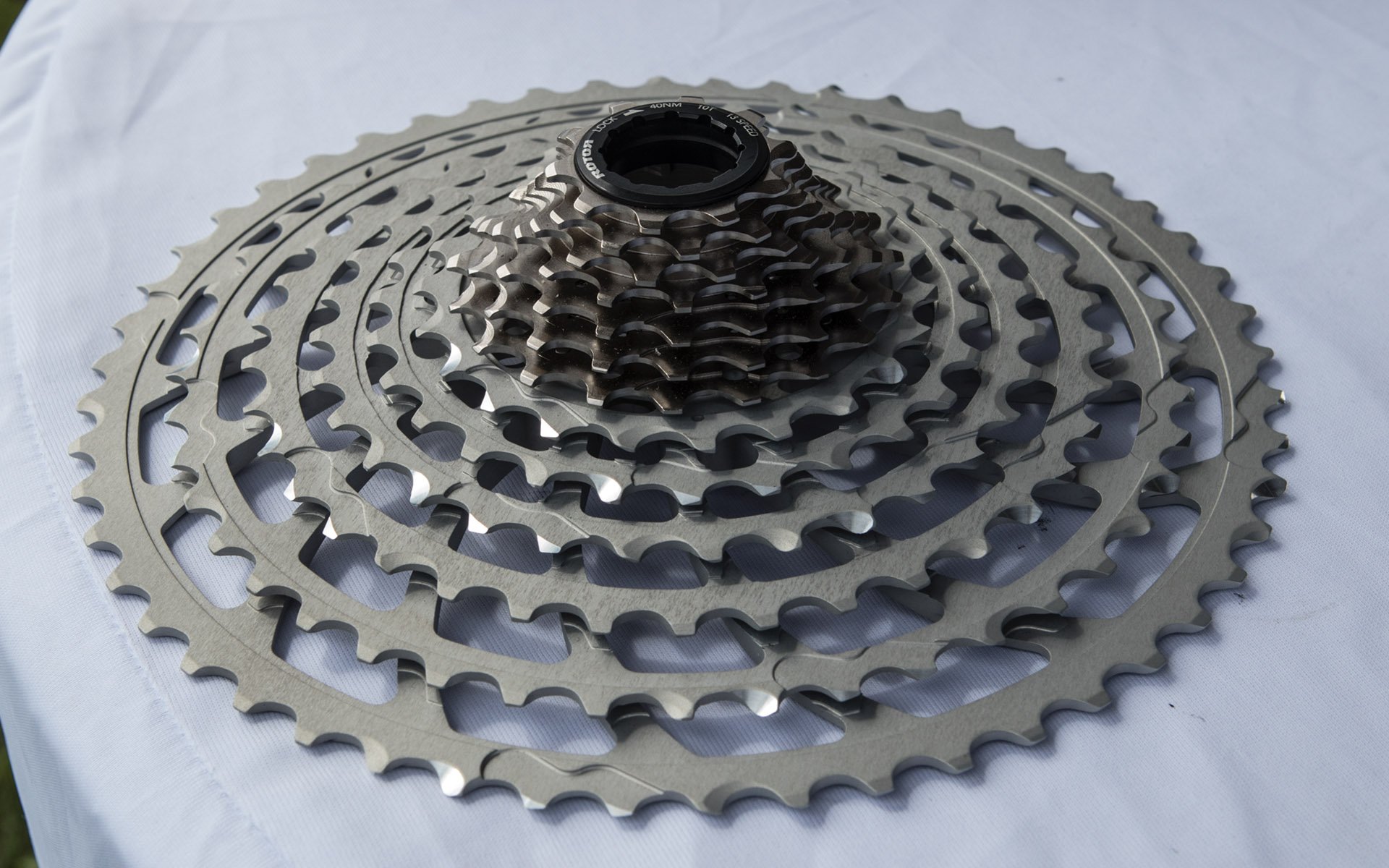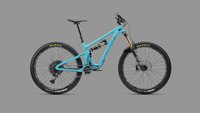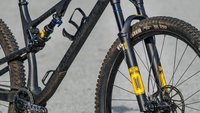
Sea Otter 2019
Rotor Components - 13 spd Hydraulically Actuated Shifting
Rotor introduced an unlucky road bike drivetrain at last year's Eurobike, and now they have a pie plate of a mountain bike cassette mated to a hydraulically actuated rear derailleur. We were told that ditching cables was one solution to the maze of patents related to bicycle changers, because they apparently relate only cable actuated derailleurs.

While a yearly oil change is recommended, Rotor suggests the system will be virtually maintenance free. They also claim it is lighter than either a battery or cable actuated system. Chains are provided by KMC. The entire drivetrain is said to be about 60 g more than the top of the line competition.
Just 4cc of unpressurized* mineral oil move the mechanism up and down the cogset. A shallow push on the lever pushes the fluid producing a downshift. A deeper shift releases pressure allowing gravity and the return spring to drive the train to a smaller cog.
*before actuation that is

The derailleur with a dustcover removed reveals an intricate mechanism. Rotor manufactures these parts in their Spanish facility.

It's a little clunky looking but the electric shifting options on the market are as well. In the event of fluid loss it's possible to set the chain on the cog of your choice.
The cogset is an interesting combo with the smallest 7 steps made of steel while the largest 6 are machined from a single piece of aluminum. We were told the cassette is both lighter and less expensive at retail than an XX1 model, which doesn't help most of us much at this point. A custom spaced hub is required to make space for that 13th cog.

10-52! The steps are nice and even, without the abrupt jumps found on some cassettes. The second largest cog is a 44 rather than the 42 found on Eagle cassettes. The 12 spd version is 11-52 and it will fit on a standard hub/Shimano driver.

Rotor claims the 13 spd version weighs just 306 g compared to 360 g for an XX1 12 spd.
Fortunately Rotor is also going to produce a 12 spd version of the cassette and all that's required to convert the system is an adjustment to a limit screw. Both versions use a 12 spd chain and the system slides onto a conventional Shimano HG cassette, with the smallest cog sitting outboard and doing double duty as the lockring.

That wee fin disengages the clutch for easy wheel changes. There is also an 'origin' button which drops the chain to the smallest cog - also to ease wheel removal and installation.

That tiny line? It should feed easily through any internal routing system. When compared to a cable system, this actuation configuration has virtually no friction.
Lori Barrett from Rotor told me cassettes would be available in May, and full groups in the fall. Hopefully it will get to market before long and we'll have to wait and see if the prices end up above or below top end groups from the competition. I can't see ditching hubs to try the 13 spd incarnation of this but 12 spd piques my interest, as does the actuation method. This seems like a simple application for hydraulics that may produce improved lever feel and reduced maintenance. For more technical information check this document from the Rotor web site or the North American site here...







Comments
kmag76
5 years, 1 month ago
Looks nice, but all those aluminum cogs in my experience will wear a heck of a lot faster than steel.
I had a beautiful Hope cassette, and wore out the top cluster in a few months.
Reply
Cam McRae
5 years, 1 month ago
They are working on having replacements for the two halves of the cassette, but you are not mistaken.
Reply
AustinLori
5 years, 1 month ago
We did a lot of testing, and because there is less chain wrap on the bigger cogs, there is generally less wear. We did the same on the road cassettes that have been in production for a couple of years, and they wear really well, from what we've seen.
Reply
Velocipedestrian
5 years, 1 month ago
More chain wrap?
Reply
Shoreboy
5 years, 1 month ago
The idea of a hydraulic derailleur is an interesting exercise, but hardly practical. Where are you supposed to properly route those lines if you dont have internal routing? In my opinion the only 'progressive' move away from a cabled derailleur is something wireless.
I cannot imagine a need for 13 gears ever. I dont use the entire range on my 11-speed cassette. How about a cassette that doesnt have an 8t gear jump at the upper end? Going from 52t to 44t is a big drop in gearing. Id rather have smaller increments at the upper end (how about 52-47-42 or 52-46-40) that will help me stay in an efficient climbing gear. Get rid of the 10t at the bottom and make the gearing more even at the top.
Reply
Andy Eunson
5 years, 1 month ago
13 gears doesn’t bother me considering my first mountain bike had 15 gears. But you raise a good point about range. What a rider needs is useable range. Around Whistler I want a pretty low low gear but a high gear isn’t very useful. I find a 32 by Eagle is close enough for my needs. Others would want something different than me that conforms to their own strength and local terrain needs. Road riders can get all sorts of cassette ratios. Why is off road a sort of one size fits all?
Reply
Perry Schebel
5 years, 1 month ago
i think the standard eagle cassette is pretty close to a universal catch all. whether you run a 28 or 36t chainring, or somewhere in between (depending on your terrain and/or size of your quads), i don't think there's a a sizable percentage of riders that can't be effectively serviced by this range.
Reply
Shoreboy
5 years, 1 month ago
The 50t to 42t jump is too much in my opinion. Do you really need a 2t increment starting at the bottom? 10t-12t-14t-16t-18t? Then at the top you go 36t-42t-50t?
There is no way most riders need that tight gearing at the bottom (for mtb) and could definitely use something between the 42t and 50t.
As Andy said, why cant we have a different cassette for those that climb (spin) and those that hammer?
OneUp got it right in my opinion, using an 11-42t cassette and adding a 47t extender. Perfect spacing and all the range you need.
Reply
AustinLori
5 years, 1 month ago
Hi! Here's a link to the gear ratios. We agree that the jump at the end is pretty big, which is why we cut the gap from Eagle in half. You can find the direct comparison at the bottom of the that link. It's pretty cool!
We also spread out the lower cluster a lot compared to competitors; we worked with our pro riders to see what gearing they tended to use, then made cogs *that size, rather than simply working off a ratio.
Reply
AustinLori
5 years, 1 month ago
It's true. 13s is mostly about offering better steps in the gearing, rather than increasing the gear range, TBH.
Reply
Velocipedestrian
5 years, 1 month ago
"an unlucky road bike drivetrain at last year's Eurobike"
What was unlucky about it?
Reply
Please log in to leave a comment.